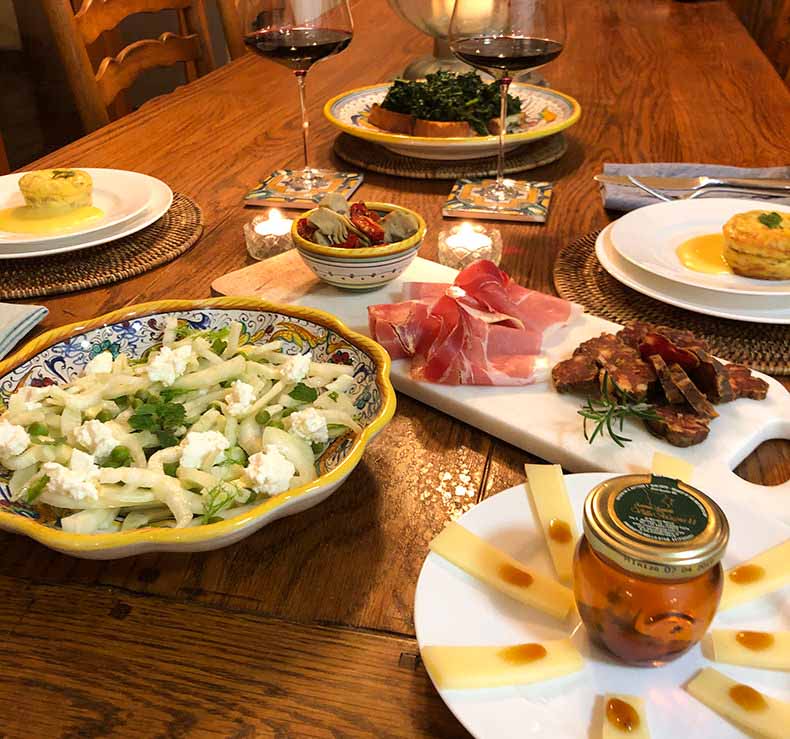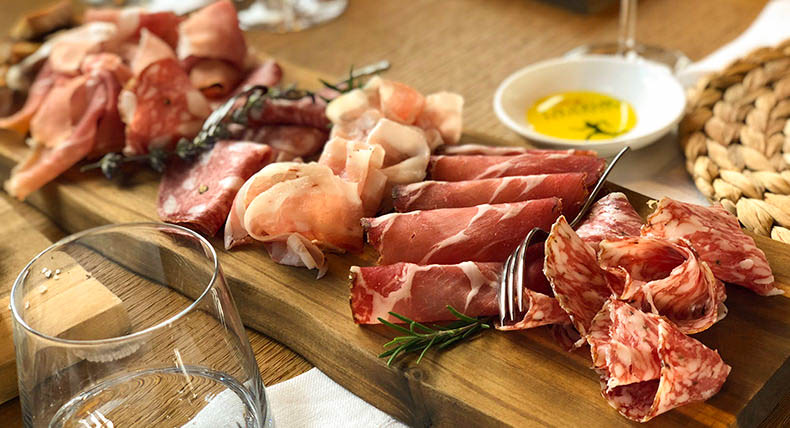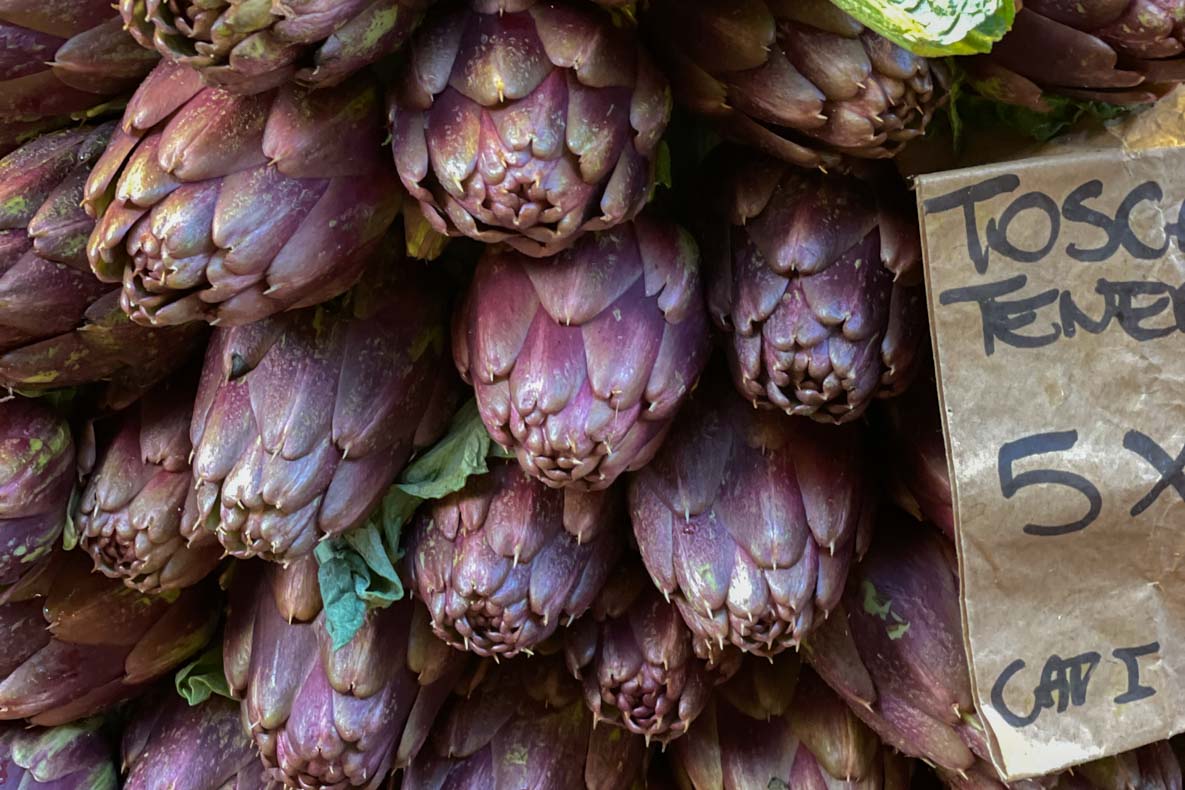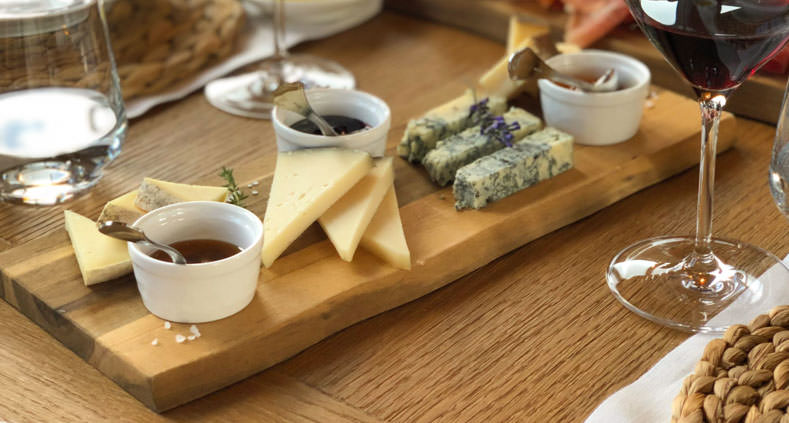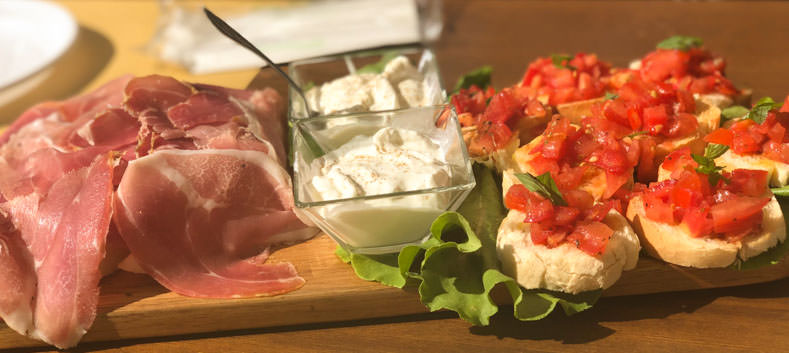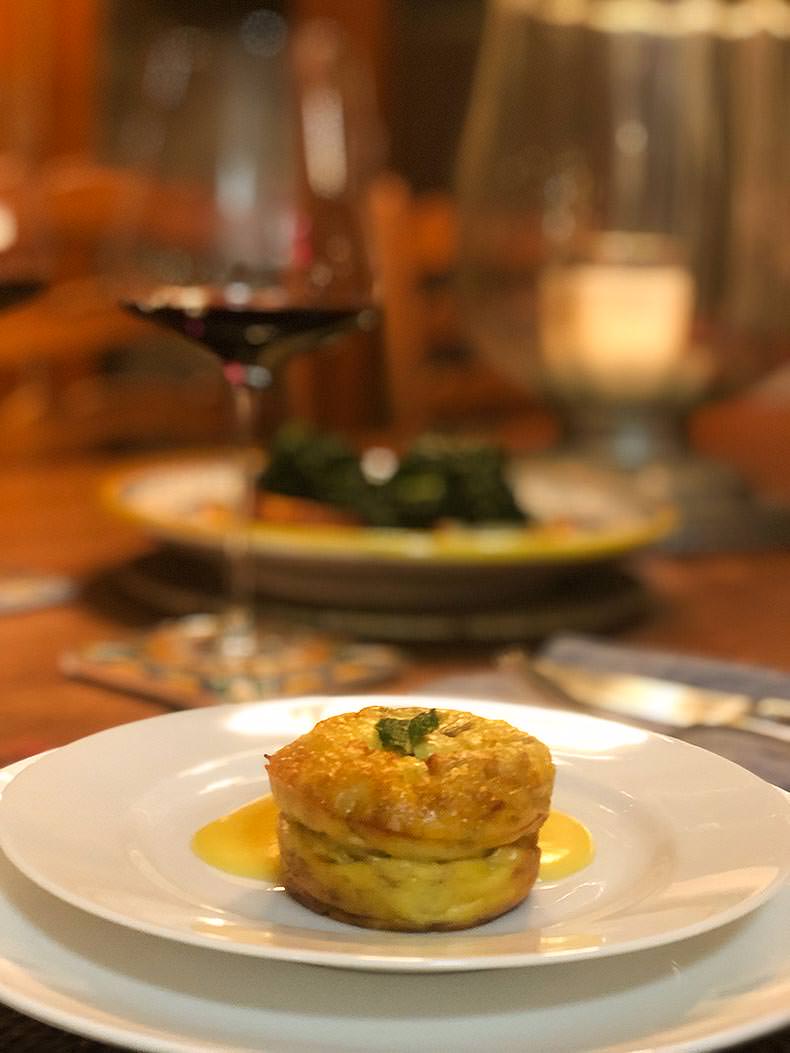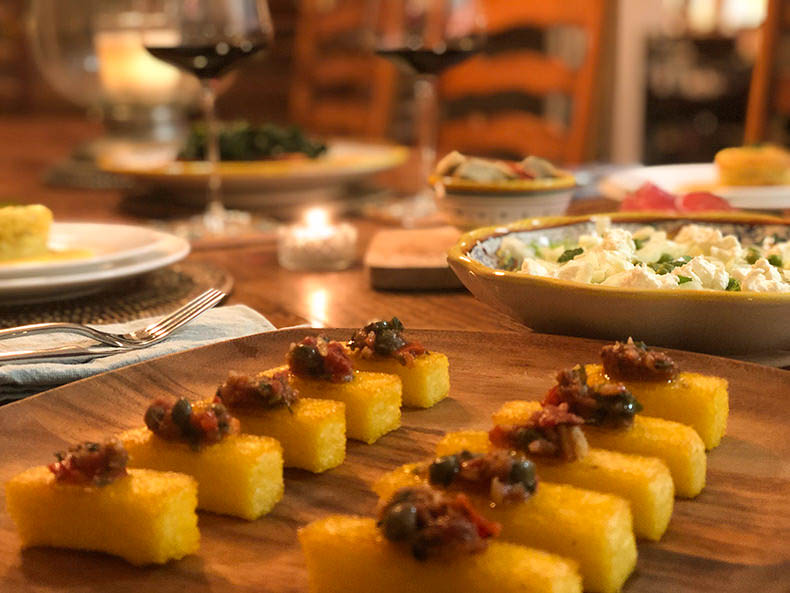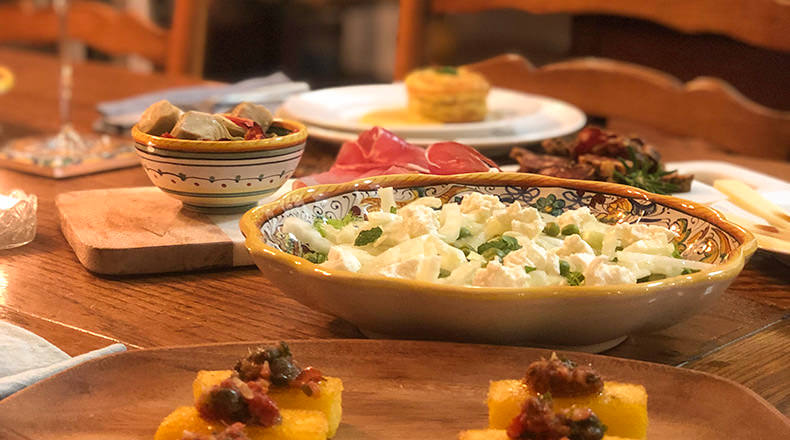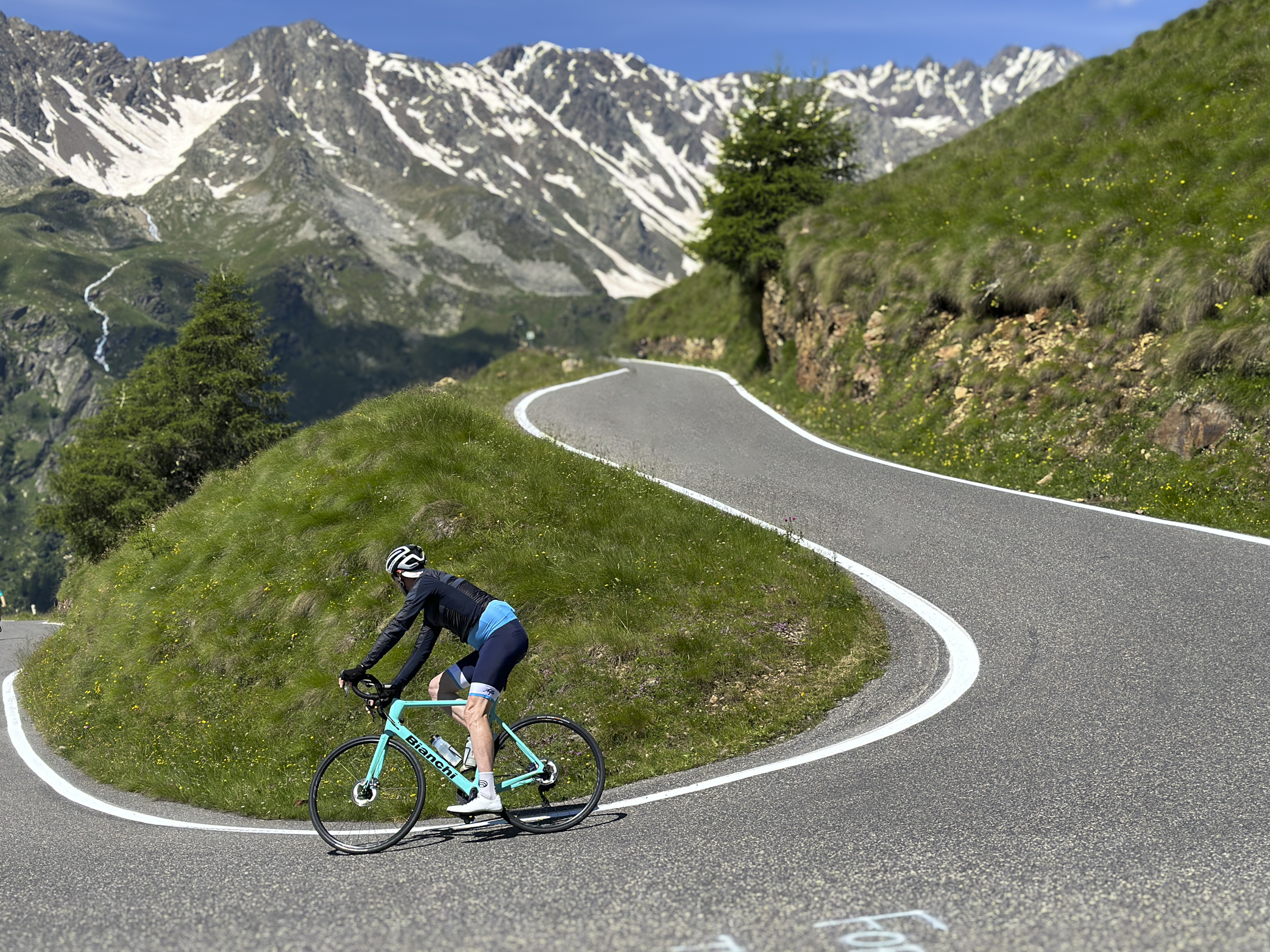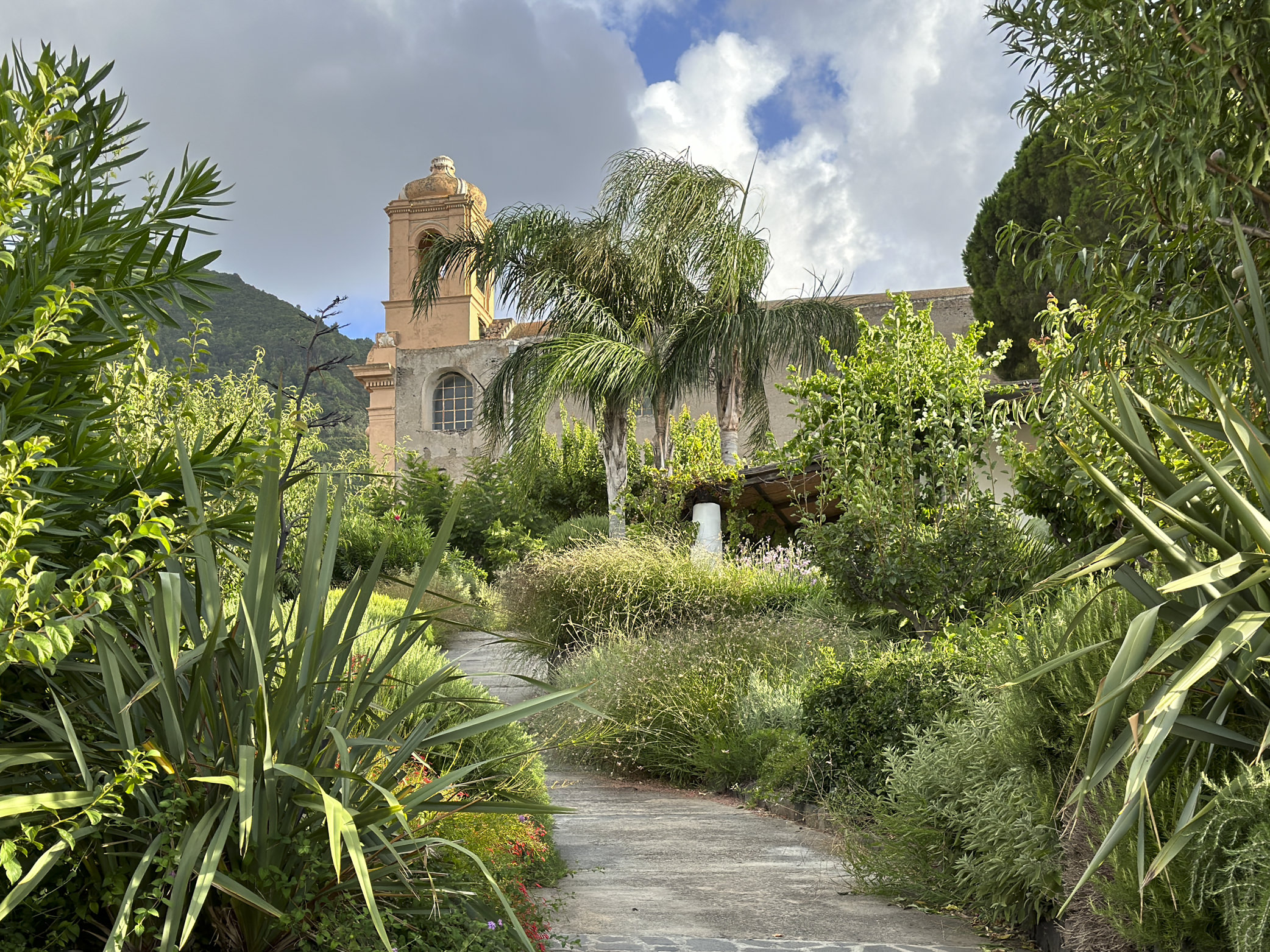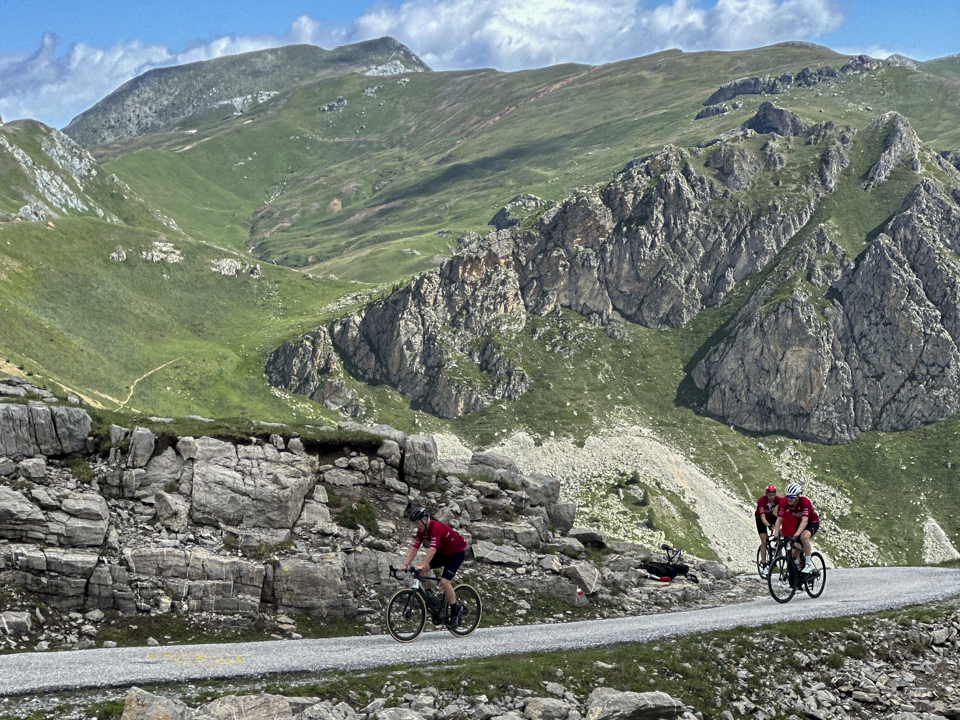At Tuscan gatherings of family and friends, antipasto is almost always served at the start of a meal, with a collection of plates and platters of varying tastes presented in the middle of the table. Always a celebration of seasonal produce, the dishes vary from season to season, with a couple remaining constant throughout the seasons. Each person selects their own plate and it’s the perfect start to a meal.
Of course, there are so many variations to the Antipasto Toscano and we get to experience quite a range of these dishes across our various Tuscany Cycling Tours and L’Eroica Cycling Tour each year (except this year!), but there are always some traditional dishes that really talk to the heart of Tuscany’s fresh, seasonal produce-based cuisine. So, as part of our virtual tour of Toscana this month with our tour guests, we have chosen to prepare and cook some of the more traditional antipasto tastes, to give us a sense of authentic Tuscany.
Affetato Misto
No matter the season, a Tuscan Antipasto always includes a plate of assorted cured meats. Although the meats can vary slightly depending on the region of Tuscany it is being served in, it will nearly always include Prosciutto, a Salami and often it will be Finocchiona, which is a large, soft salami flavoured with fennel seed, and in some areas, the Salsicce di Cinghiale (dried wild boar sausages) which are small and often spicy, are served. The Cinghiale is a bristle-haired, dusky brown wild boar that is wild and hunted in many parts of Tuscany, and is why you’ll often see it on a Tuscan menu, for antipasto, primi and secondi, and particularly in the Autumn and Winter.
Sott’olio or Sott’aceti
Whatever the combination of cured meats presented at an Antipasto Toscano, there will also nearly always be an assortment of vegetables preserved in olive oil (sott’olio) or vinegar (sott’aceto). Often in Tuscany, we get to enjoy artichoke hearts and porcini mushrooms preserved in olive oil as these are in abundance in our home region of Chianti, and as for ‘preserved in vinegar’, often we enjoy small pearl onions or Giardiniera, a pickled vegetable selection most often made with cauliflower, carrots, onions, peppers and sometimes celery or beans. There are many recipe variations for these classic Italian pickled vegetables, so often served with antipasto all over Italy, particularly because their light, tangy taste complement the affetato misto or salumi across all regions, perfectly.
Pecorino cheese
Pecorino cheese is made from sheep’s milk and is eaten all over Italy, however Pecorino di Pienza, a pecorino made in and around the small renaissance town of Pienza in Tuscany, a town which we visit on our cycling Tour of Tuscany, has a long history. The ancient Etruscans produced and consumed pecorino cheese as a staple in the Val d’Orcia, and in this valley, this delicious cheese is still made here today, the same way it has been produced for thousands of years.
The unique taste and firm texture of this cheese is due to a unique combination of the clay soils of the Val d’Orcia, the sheep which are of Sardinian breed and of which there are only 3000 in Pienza, and the milk of this breed, which is sweet and complex. Made in very small volumes from only a very small number of 10-12 of artisanal producers, the traditions and craft skills of the past farmers of Sardinia, experts in the production of pecorino, who moved to Tuscany with their sheep, are still honoured today, making this territory a point of reference for cheese production.
Starting with Pecorino Fresco, which is only aged for 30 days and is ideal to eat fresh or to melt, to the semi-staggionato aged from 2-5 months, which has a crust treated with olive oil, to the gran-riserva, which is aged anywhere from 6 months to 2 years, there are many styles of this special cheese to be enjoyed. Some are rubbed with ash, some covered in straw, and some pressed with tomatoes, but it is the various ageing stages of Pecorino that determines how it is eaten and what it is paired with. We love a semi-staggionato pecorino with drizzles of local truffle honey or vin santo jam. Delicious.
Crostini e Bruschetta
The other component to a traditional Antipasto Toscano is crostini e bruschetta. Crostini are usually made with small slices of untoasted bread, while bruschetta is made with thick and larger slices of toasted Tuscan bread. A few standard toppings exist but the classic Tuscan crostini for which every family has its own recipe, are crostini di fegatini, a pate of chicken livers made together with anchovies, capers and red wine, or most commonly the sweet Tuscan dessert wine, Vin Santo.
Bruschetta tends to be more rustic and seasonally based. Around late October/November in the Autumn, when the olives have been harvested and pressed, thick slices of bread are toasted on the grill, rubbed with garlic, and bathed in the olio nuovo (new olive oil) or covered with cooked fagioli bianchi (white beans) and olive oil, or cavolo nero (Tuscan black cabbage) and the new oil.
Of course, the better known and much loved bruschetta by many around the world is topped with tomato, basil and olive oil, and of course is mostly eaten in Summer when tomatoes and basil are in season. One of the very simple tips in making a tomato and basil bruschetta that we learned recently in a Tuscan cooking class as part of our non-riding partner program, is to dice the tomatoes to be very small to reduce their surface area and to salt them, setting them aside for 20-30mins to reduce the water content and bring out the intense flavours of the tomato. Then just drizzle olive oil on top and a basil leaf. Buonissimo!
Frittata, Tortino or Sformato
When antipasto is shared almost as a meal itself, you will often find a dish that is made with eggs. Whether a frittata, an omelette style popular throughout Tuscany made with potato and onion, or a seasonal vegetable such as asparagus or zucchini, or a tortino or sformato, a favourite in Siena, that is a rustic egg and vegetable flan baked in the oven with onion or spinach or zucchini, and nearly always with a pecorino cheese sauce, this additional egg dish really does make the meal almost complete.
We are cooking a sformato con cipolle e pecorino as part of our cooking class this month with tour guests, and it is simply delicious. We have also enjoyed this same sformato in Tuscany (albeit using the amazing red onions of Tropea that we don’t have in Australia), teamed with pecorino and truffle, and it is next level amazing!
Crostini di Polenta
Sometimes you will also find polenta-based antipasti in Tuscany, most often in the Autumn and Winter. Often used as a substitute for bread, and commonly referred to as Crostini di Polenta, these tasty morsels can be fried or baked in the oven. Often paired with fresh porcini mushrooms in the Autumn, or using the dried version with water when out of season, these crostini are topped with Tuscan pecorino cheese or parmesan, and are delicious.
Crostini di Polenta are also often paired with a little anchovy salsa, which is also delicious and is what we are preparing for our Antipasto Toscano, or they can quite simply have parmesan grated over the top of them. Delizioso! An all-round versatile and simple antipasto taste to make and to add to your Tuscan table.
Insalata
To complement all the tastes of an Antipasto Toscano, there is also often a little insalata or salad of in-season vegetables such as fennel or rucola. A typical salad may be an insalata di finocchio, arancia e pecorino, a mix of thinly sliced raw fennel, orange segments and pecorino cheese, which is so refreshing and delicious. Or quite simply, fennel slices topped with a drizzle of olive oil and parmigiano.
An insalata Toscana style can also include fresh fruit such as figs when they are in season, wrapped in prosciutto. This is an all-time favourite that we devour when in Chianti with friends who bring over baskets of home-grown figs from their trees. It really doesn’t get much better.
So, whatever your tastes and whatever the season, there is always a selection of Antipasto Toscano dishes that you can prepare for your friends and family, savouring a slice of Italy at home. Here we share just a few of our recipes that we prepared this past weekend and will prepare with guests this week.
Recipes
Sformato di cipolle e pecorino (Sweet onion flan with pecorino cheese sauce)
Ingredients for 4 people
For the sformato
6-7 shallots (approx. 320-350g)
200 ml fresh cream
4 eggs
salt
pepper
For the sauce
300 g semi matured Pecorino Cheese
100 ml fresh cream
1 egg yolk
Method
For the sformato
Cut finely the onions or shallots and stew them in a pan over a slow to medium heat, allowing them to lose all their moisture, approx. 15-20 minutes. Once cooked, place them in a blender to obtain a soft pureè.You should have approx 200 g of onion puree, to which you add 200 ml of fresh cream and 4 eggs, salt, pepper and mix well. Pour the mixture into 4 ramekins or a muffin pan and bake at 150° for 20-25 minutes. Once cooked, let them cool down.
For the sauce
Grate the Pecorino Cheese. Then put 100ml of fresh cream in a saucepan on a medium heat. When it begins to boil, turn off the heat and add the Pecorino Cheese, the egg yolk and with a whisk, mix it quickly. Add salt and pepper and keep warm.
To serve, place the sformato on a flat serving dish and drizzle with a little of the sauce. Sprinkle with pepper.
Polenta con Acciugata (Crostini di Polenta with an Anchovy Sauce)
Ingredients for 6 people
For the polenta
1 cup coarse-grain polenta
4 cups water
Salt
For the sauce
4 large olive oil packed anchovies
2 tablespoons chopped tomatoes (fresh or canned)
1 tablespoon capers
1 clove garlic
1 teaspoon finely chopped parsley
1/3 cup extra virgin olive oil
Method
For the polenta
In a deep saucepan over high heat, bring the water to a boil and salt lightly. Pour in the polenta in a thin steady stream, stirring constantly. Reduce the heat to low stirring continuously with a wooden spoon, for about 10 minutes. The polenta is ready when it becomes quite thick and pulls away from the sides of the pan as you stir it. Remove from the heat.
Oil the bottom and sides of a 23 by 30cm baking dish and pour the polenta in, smoothing the surface. Let the polenta cool for an hour in the fridge or it can even be kept overnight in the refrigerator.
Turn the polenta onto a cutting board and cut into 5 x 2.5cm rectangles.
For the sauce
To make the sauce, warm the olive oil in a saucepan over low heat. Add the garlic and saute, about 1 minute. Add the anchovy fillets and using a wooden spoon, break them apart in the pan. Cook, stirring occasionally until the sauce thickens slightly, about 5 minutes. Stir in the tomatoes, capers and parsley, raise the heat to medium and cook uncovered for 10 minutes. Remove from the heat, cover and set aside.
To prepare the polenta crostini, heat a frying pan with a small amount of olive oil and seal until crisp and golden on both sides or heat in the oven at 200 degrees celsius for 30minutes, turning at the mid way point. Rest on paper towel on a wire rack and then keep warm in a low oven until serving.
When ready to serve, arrange the hot polenta crostini on a platter and top each slice with a teaspoon of the sauce. Serve immediately.
Insalata di Finocchio e Parmigiano
Ingredients for 4 people
1 bulb fennel, finely sliced
4 tbsp extra virgin olive oil
2 tbsp fresh lemon juice
2 tbsp chopped parsley and thyme
3-4 tbsp shaved parmesan cheese
Method
Gently toss all of the ingredients together, and top with the parmesan shavings (or even ricotta if you choose).
Join us in Tuscany to have the chance to sample the absolutely diverse and wonderful cuisine that we get to experience on tour. For more information on our Tour of Tuscany dates in 2021, visit our tour page.

